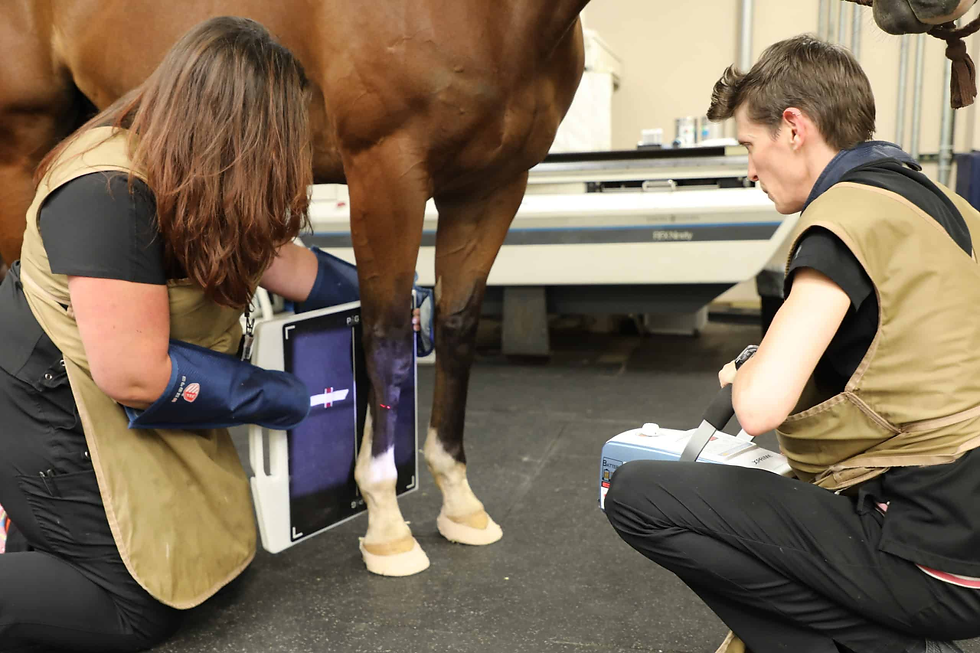How Diagnostic Imaging Helps Us Treat Your Horse
- Ella Riley CertNCS (VCC), RVCCA

- Oct 24
- 2 min read
When a horse is lame, sore, or just “not quite right,” one of the most important tools we have in veterinary medicine is diagnostic imaging. From subtle lameness investigations to diagnosing serious injuries or monitoring ongoing conditions, imaging plays a vital role in helping us see beneath the surface.
In this blog, we’ll explain what diagnostic imaging is, the different types we use, and how it helps us provide faster, more accurate treatment for your horse.
What is Diagnostic Imaging?
Diagnostic imaging refers to a range of techniques that allow vets to visualise the inside of your horse’s body, including bones, joints, soft tissues, and internal organs.
It’s essential for:
Diagnosing lameness or injury
Investigating poor performance
Guiding treatment plans
Monitoring healing or progress over time
Ruling out more serious conditions
Common Types of Imaging We Use
1. Radiography (X-rays)
X-rays are ideal for examining bones and joints, and are commonly used to:
Diagnose fractures
Detect arthritic changes
Identify OCD lesions or bone chips
Assess conformation and developmental issues
Monitor healing post-injury or surgery
We often take X-rays during pre-purchase exams as well, to give a clear picture of underlying structures.
2. Ultrasound (Sonography)
Ultrasound uses sound waves to create real-time images of soft tissues, such as:
Tendons and ligaments
Muscles
Joints (e.g., synovial structures)
Abdominal organs
The reproductive tract
This is a key tool for diagnosing tendon injuries, monitoring healing, and guiding injections or other treatments with precision.
3. Endoscopy
Endoscopy uses a camera on a flexible tube to view inside the airways or stomach. It’s essential for:
Diagnosing gastric ulcers
Investigating poor performance or abnormal breathing
Identifying infections or obstructions
4. Advanced Imaging (MRI / CT / Scintigraphy)
These modalities are more specialised and performed at referral centres, but we work closely with such facilities when advanced diagnostics are needed. They can be especially helpful for:
Complex or unresolved lameness
Neurological cases
Detailed imaging of the foot or spine
Why Imaging Matters in Equine Veterinary Care
Horses are large, athletic animals that can’t tell us where it hurts. Diagnostic imaging lets us:
Pinpoint the problem rather than guess
Avoid unnecessary treatments
Treat earlier — improving the chances of full recovery
Track progress and make informed decisions
Without imaging, we’re often working in the dark. With it, we can give you answers — and your horse, the care they truly need.
Imaging at Our Practice
Our practice is equipped with portable digital X-ray, endoscopy, gastroscopy and ultrasound systems, which means we can often perform these diagnostics right at your yard or in the field, saving time and stress for both you and your horse.
We work closely with local hospitals to refer when advanced imaging is needed.
Need to Investigate Something Further?
If your horse is lame, uncomfortable, or you feel something’s not quite right, don’t wait.
Early imaging leads to earlier answers, and often, a much better outcome.
Get in touch with us today to book an assessment or speak to one of our vets about what diagnostic imaging might be appropriate for your horse.





Comments